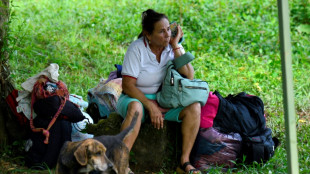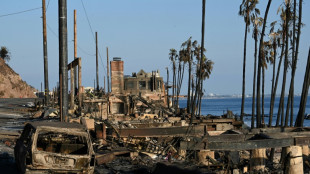

Australians flee floods as toll rises to 12, Sydney on alert
Floodwaters crashed into more towns on Australia's east coast as a deadly storm front barrelled south on Wednesday towards Sydney, where the main dam began to spill water.
The death toll rose to 12 in a week-long disaster that has washed cars from roads and forced tens of thousands of people to evacuate their homes as waters lapped at balconies and roofs.
"This is terrible. This is terrible. One life lost is too many," said New South Wales deputy premier Paul Toole after confirming a third death in the flood-hit town of Lismore.
After bringing havoc to Queensland, the storm front moved southwards, dumping vast quantities of water and sparking a string of flood alerts in New South Wales including Sydney, Australia's largest city.
"Today, the focus is on Sydney. We are expecting heavy rainfall over the afternoon into the night and into tomorrow," Toole warned in a news conference.
Sydney's main Warragamba dam, lying southwest of the city, had reached capacity and started spilling water in the early hours of Wednesday morning, Toole said.
He told residents at risk to flee if they are told to do so.
"If you are getting a knock on the door, if you are asked to leave, please leave," Toole told a news conference.
"We are looking at substantial rainfall over the coming days. We don't want to see those images where people were standing on the roofs of their houses, not leaving and then having to be rescued."
In the coastal town of Ballina in New South Wales, some 55 hospital patients were evacuated overnight -- hours before a high tide from the sea combined with waters overflowing the banks of Richmond River.
A "makeshift emergency department" was set up in a Catholic college for urgent cases, regional health officials said.
- 'Eerie' -
An hour inland from the coast, water levels in Lismore were falling but resident Tom Wolff prepared to head out for rescues.
"It all feels kind of eerie now, is how I would describe it," he said.
The hardest part was trying to navigate around power lines and other hazards in a boat, Wolff said.
"We know the streets of Lismore, but it's just totally different when you're 10-12 metres above them," he said.
"There are signs around town for the '74 flood levels, but they were underwater."
At one house, they rescued a sausage dog that had been left at the highest point of the house.
"She must have just been treading water for god knows how long, maybe hours. Her heart rate was through the roof when we found her," he said.
In an airfield in Grafton -- where residents saw buildings submerged almost to roof level this week -- flight club president Bob King rowed out in a metal dingy to check on his aircraft as the smell of fuel hung in the air.
Most of the 25 aircraft at the field were now underwater, he said.
Flight instructor Peter Clement surveyed the damage done to his planes -- four light aircraft each worth Aus$100,000 ($73,000) -- sitting half-submerged in a hangar where the mud-brown waters came up to his waist.
"I'm hoping it's not a total loss," he said.
"This is the biggest flood I've ever seen and I've been here 20 years."
Australia has been on the sharp end of climate change.
Droughts, deadly bushfires, bleaching events on the Great Barrier Reef and floods have become more common and intense.
Because a warmer atmosphere holds more water, scientists say climate change increases the risk and intensity of flooding from extreme rainfall.
T.Zangari--IM



